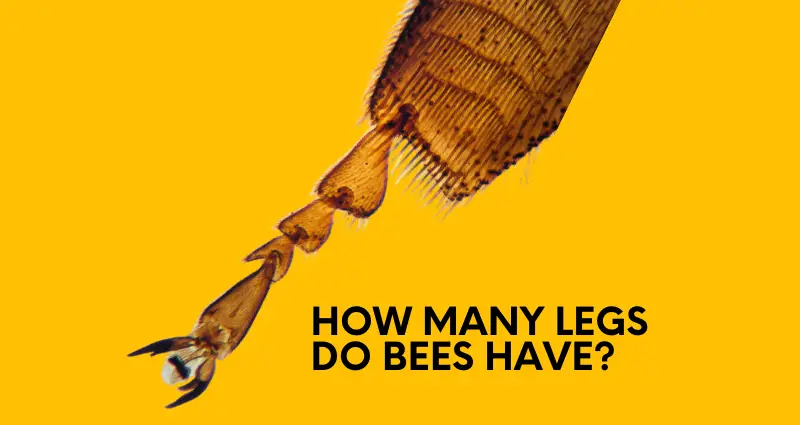Bees have six legs. Not only do bees use them to walk but they rely on them when gathering pollen, building the hive, grooming, communicating, and more. The middle legs stabilize the bee while the front and back legs have unique capabilities.
Three pairs of legs, six total, are attached to the honey bee body. Bees are well-engineered creatures with versatile legs that assist them in gathering pollen, grooming, tasting, and walking.
The three sets of two legs are:
- Forelegs, which are closest to the head.
- Middle Legs, which are between the foreleg and hind leg.
- Hind Legs, are farthest from the head and equipped to assist in gathering pollen.

What Do Bees Use Their Legs For?
Bees use their legs for a lot more than getting around. The legs of a bee function like both arms and legs in humans, plus do a few other things as well.
- Walking, running, and dancing. When bees are not airborne, they use all six legs to move around on the ground, in the hive, or on surfaces like flowers. They also use their legs to perform the waggle dance to communicate with the other bees.
- Pollen gathering. Honey bees and other species who collect their own pollen (in contrast to varieties such as cuckoo bees, who steal it from other bees) rely on their hind legs in the process. The legs are equipped with tools to collect and carry pollen called the press, brush, and auricle. Honey bees and bumblebees have pollen baskets called corbicula (single ) or corbiculae (plural) to store the pollen after collections. Some solitary bees, such as mining bees, have curled hairs or floccus on their legs that act as pollen brushes.
- Tasting. Honey bees and some other species of bees use their front feet along with their tongues and jaws to taste via hair-like sensors located on various parts of their bodies.
- Hearing. Bees lack ears, but subgenual organs in the legs pick up sound vibrations that they use to communicate.
- Grooming. Bees have adaptations on their feet that help them keep their antennae free of bacteria and micro-organisms that could threaten their pollen and compromise their food supply.
- Grabbing. Bees’ legs enable them to grab and shake flowers to free the pollen or defend the hive.
- Building. The honey bee’s or bumblebee’s legs come in handy in constructing nest cells from wax, while other species use them to line their cell walls.
- Gathering and carding. Some types of bees even use their legs to gather materials they use to build their habitats.
Bees put all their legs to use but can survive if they lose one of their middle legs. The front and hind legs are important for so many functions that they would be severely impaired if they lost those.
What Are The Parts Of A Bee’s Leg?
A bee has a segmented leg that includes six segments: the coxa (1st), trochanter (2nd), femur (3rd), tibia (4th), metatarsus (5th), and tarsus (or foot – 6th.) The legs are very flexible.
The pollen basket is located on the tibia, while special tools for gathering pollen are situated on the metatarsus. What a single bee collects during a day can account for 30% of its weight.
However, a single bee collects only enough pollen to make 1/12th of a teaspoon of honey in its lifetime; when all the worker bees in the hive do their jobs and bring home saddlebags full of pollen, the honey production from the hive is 2 to 4 pounds per day.
The leg action provides enough honey and pollen to feed the hive population, including the brood, and store the surplus.



Are The “Bee’s Knees” A Real Thing?
As with a human leg, the bee has a knee between the femur and the tibia. Many diagrams of the bee’s anatomy do not label it as such, but as it is a joint between the two parts of the leg, it is appropriately considered a knee.
While the rest of the leg helps with life functions, such as pollen gathering or grooming, the knees have no particular function.
The “bee’s knees” is the subject of an expression used for centuries. While the specific meaning has changed, it was most recently popularized in the 1920s as a clever way of saying “the very best.”
Do Bees Have Toes?
Bees do not have toes. They have tarsal claws at the end of the tarsus or foot, which are comparable to hands and feet in humans.
In humans, toes consist of several bones that help with weight distribution, balance, and posture. The tarsal claws that the bees have do not require a phalange to provide what the bee needs to do its work.
The claws help grip the surfaces of flowers, discern salty and sweet tastes through sensory hairs found on the tarsal claws on the front legs, and deposit a pheromone from a tarsal gland on the leg to communicate with other bees.
The six legs of bees are flexible and quite valuable for procuring and ensuring the safety of pollen.
For more info on Bee Anatomy, click here to read our article.



